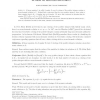Free Online Productivity Tools
i2Speak
i2Symbol
i2OCR
iTex2Img
iWeb2Print
iWeb2Shot
i2Type
iPdf2Split
iPdf2Merge
i2Bopomofo
i2Arabic
i2Style
i2Image
i2PDF
iLatex2Rtf
Sci2ools
JCT
2010
2010
Equations resolving a conjecture of Rado on partition regularity
A linear equation L is called k-regular if every k-coloring of the positive integers contains a monochromatic solution to L. Richard Rado conjectured that for every positive integer k, there exists a linear equation that is (k − 1)-regular but not k-regular. We prove this conjecture by showing that the equation Pk−1 i=1 2i 2i−1 xi = “ −1 + Pk−1 i=1 2i 2i−1 ” x0 has this property. This conjecture is part of problem E14 in Richard K. Guy’s book “Unsolved problems in number theory”, where it is attributed to Rado’s 1933 thesis, “Studien zur Kombinatorik”. In 1916, Schur [Sch16] proved that in any coloring of the positive integers with finitely many colors, there is a monochromatic solution to x + y = z. In 1927, van der Waerden [vdW27] proved his celebrated theorem that every finite coloring of the positive integers contains arbitrarily long monochromatic arithmetic progressions. In his famous 1933 thesis, Richard Rado [Rad33] generalized these results by cla...
| Added | 28 Jan 2011 |
| Updated | 28 Jan 2011 |
| Type | Journal |
| Year | 2010 |
| Where | JCT |
| Authors | Boris Alexeev, Jacob Tsimerman |
Comments (0)

